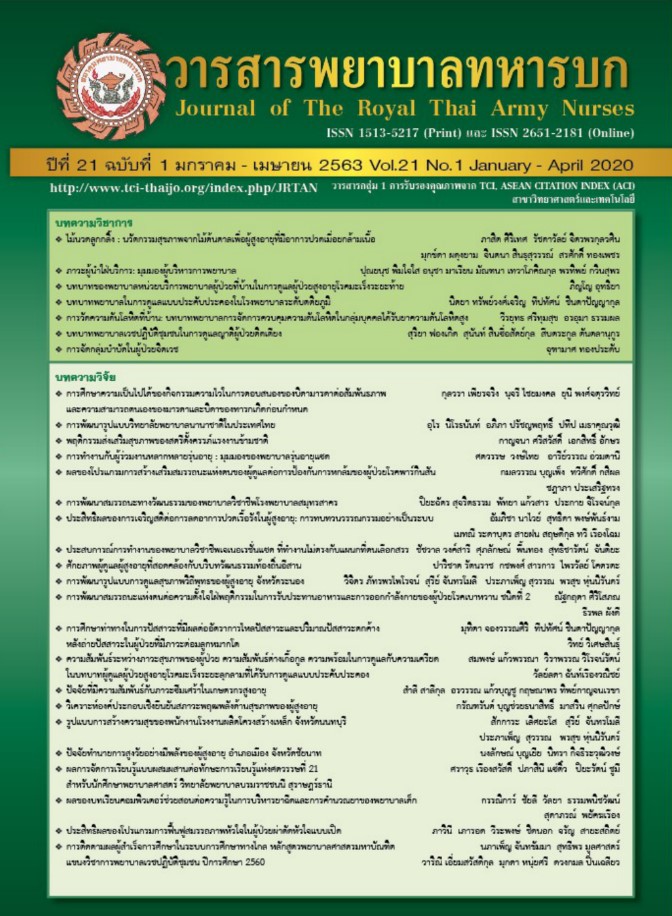The Impact of Simulation Game on Nursing Students’ Performance Skills for Intravenous Injection via NSS Lock
Keywords:
intravenous injection, simulation game, nursing studentAbstract
The quasi-experimental research aimed to study the effectiveness of the simulation game of intravenous injection via normal saline lock (NSS lock) on nursing students’ performance skills of intravenous injection, and to evaluate the nursing students’ perception of simulation game. The participants were 52 third year nursing students who were with no experience of intravenous injection. The research instruments were simulation game, performance skill assessment form, and perception questionnaire. They showed a demonstration of intravenous injection via NSS lock. Then they learned by playing the simulation game and completed the perception questionnaire of simulation game. After that, they showed a demonstration of and after learning were evaluated by research assistants. Descriptive statistic, Wilcoxon signed ranks test, was used to analyze the data.
The results showed that the mean scores of posttest were significantly higher than that of pretest (p< .01). After learning, the mean of times’ period for practice was significantly lower than that of before learning (p<.01). The score was divided into two steps that were instrument preparation and practice. For step of practice, the mean scores of posttest were significantly higher than that of pretest (p<.01), whereas there were not significant difference between mean scores of pretest and posttest in the step of instrument preparation (p>.05). The mean scores of students’ perception of simulation game was 4.49-4.87.
Downloads
References
2. Wang R, Luo O, He L, Li JX, Zhang MG. Preservative free 0.9% sodium chloride for flushing and locking peripheral intravenous access device: a prospective controlled trial. Journal of Evidence-Based Medicine 2012;Nov;5(4):205-8.
3. Goossens GA. Flushing and locking of venous catheters: available evidence and evidence deficit. Nurs Res Pract. 2015;1-12
4. Dal Molin A, Clerico M, Baccini M, Guerretta L, Sartorello B, Rasero L. Normal saline versus heparin solution to lock totally implanted venous access devices: Results from a multicenter randomized trial. European Journal of Oncology Nursing. 2015;19(6): 638-43.
5. DeVries M, Mancos PS, Valentine MJ. Reducing bloodstream infection risk in central and peripheral intravenous lines: initial data on passive intravenous connector disinfection. Journal of the Association for Vascular Access. 2014;19(2):87-93.
6. Eghbali-Babadi M, Ghadiriyan R, Hosseini S. The effect of saline lock on phlebitis rates of patients in cardiac care units. Iranian Journal of Nursing and Midwifery Research. 2015; 20(4):496-501.
7. Jamkrajang T, Khumtaveeporn P. Effect of Team - based learning in basic nursing skill practicum on nursing care skill for patient with medication injection in the second year nursing students. Journal of The Royal Thai Army Nurses. 2016;17(2):194-200. (in Thai)
8. Johnsen HM, Fossum M, Vivekananda-Schmidt P, Fruhling A, Slettebø Å. Teaching clinical reasoning and decision-making skills to nursing students: design, development, and usability evaluation of a serious game. International Journal of Medical Informatics. 2016;94:39-48.
9. Mayer RE. Incorporating motivation into multimedia learning. Learning and Instruction. 2014;29 (In press):171-3.
10. Yamane T. Statistics - an introductory analysis. 2ed. Japan: John Weather Hill; 1970.
11. Senadisai S, Prapipanish W. foundamental of nursing. Bangkok: Judtong company; 2017. (in Thai)
12. Buscombe C. Using Gagne’s theory toteach procedural skills. The clinical teacher. 2013; 10:302-7.
13. Işık B, Kaya H. The effect of simulation software on learning of psychomotor skills and anxiety level in nursing education. Procedia - Social and Behavioral Sciences. 2014;116(0):3864-8.
14. Bayram SB, Caliskan N. Effect of a game-based virtual reality phone application on tracheostomy care education for nursing students: A randomized controlled trial. Nurse Education Today. 2019;79:25-31.
15. Verkuyl M, Hughes M. Virtual gaming simulation in nursing education: a mixed-methods study. Clinical Simulation in Nursing. 2019;29:9-14.
16. Johnsen H, Fossum M, Vivekananda-Schmidt P, Fruhling A, Slettebø Å. Developing a serious game for nurse education. Journal of gerontological nursing. 2018;44(1):15-9.
17. Tongdee S. The Effect of Using A Computer Assisted Instruction (CAI) About Nursing Care of Critical Patients with Intercostal Drainage Toward Knowledge of Professional Nurses in Police General Hospital. Journal of The Royal Thai Army Nurses. 2019;20(2):178-185. (in Thai)
18. Strickland HP, Kaylor SK. Bringing your a-game: Educational gaming for student success. Nurse Education Today. 2016;40:101-3.
19. Thongpaknum C. The Relationships among Knowledge, Attitude and Behavior in Using Information Technology for Nursing of Air Force Nursing students in Royal Thai Air Force Nursing College, Academic Year 2016. Journal of The Royal Thai Army Nurses. 2017;18(3):217-227. (in Thai)
Downloads
Published
How to Cite
Issue
Section
License
บทความหรือข้อคิดเห็นใดใดที่ปรากฏในวารสารพยาบาลทหารบกเป็นวรรณกรรมของผู้เขียน ซึ่งบรรณาธิการหรือสมาคมพยาบาลทหารบก ไม่จำเป็นต้องเห็นด้วย
บทความที่ได้รับการตีพิมพ์เป็นลิขสิทธิ์ของวารสารพยาบาลทหารบก
The ideas and opinions expressed in the Journal of The Royal Thai Army Nurses are those of the authors and not necessarily those
of the editor or Royal Thai Army Nurses Association.






